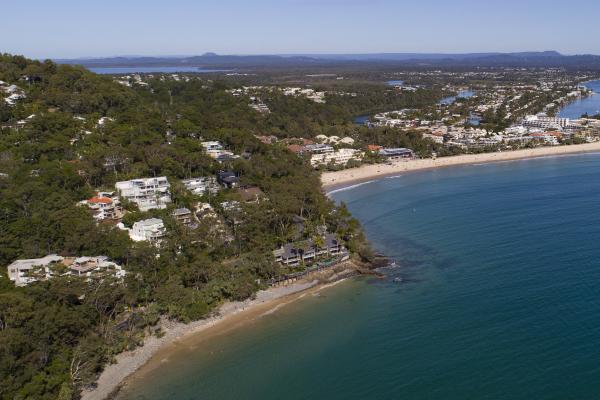PRECEDE
Deputy Mayor Frank Wilkie explains what the new Noosa Plan means to us.
From July 31, Noosa will have a new planning scheme that sets a vision for the shire’s evolution over the next 20 years.
Its aims include fostering prosperity, protecting the lifestyle and natural assets we all love and respecting the character of the shire’s many distinct localities. This is to be done by focusing population growth around existing employment and transport centres, while encouraging smaller dwellings to increase “affordability” for a greater range of personal circumstances.
Residential neighbourhoods will be preserved principally for permanent residents while all dwellings will be able to host some form of visitor accommodation.
The new plan also fast-tracks or removes the need for applications on new or changing businesses. It ensures adequate land for local manufacturing and greater flexibility for compatible retail and office space within industrial premises. Local food production will be supported by reducing red tape for farming, and encouraging rural enterprises.
There will be greater flexibility to upgrade Noosa Junction buildings and better protections through updated fire, flood, natural hazard and koala habitat mapping.
Noosa Plan 2020 seeks to accommodate an estimated population of 63,000 by 2041, as required under the State’s ShapingSEQ. Fortunately, the State has enshrined Noosa’s modest population capacity goals in this regional plan.
Noosa’s growth will be accommodated by increased small dwelling development around existing centres, placing residents close to employment, services, shops and transport. This means more two and three storey units around places like Noosa Junction and Noosa Civic. And, after input from the Noosa Junction Association, setback and floor area settings were altered as incentives to develop this centre to its long-standing three-storey potential. This includes units above commercial development, the so-called “shop top housing”.
Starting or changing the type of businesses will also be easier, less costly and time consuming. In 75 cases, the plan has reduced the levels of assessment or removed the need for an application. This is also intended to help businesses diversify beyond tourism-dependent and construction enterprise.
Noosa Plan 2020 also seeks to balance the social and economic impacts, both positive and negative of home-based stays and whole dwelling short term accommodation (STA). Responses to these impacts were highlighted in the case studies from around Australia and the world in the council’s Short Term Accommodation and Online Platform Issues paper, a University of Sydney research study and other data which helped guide this scheme.
There are basically two types of visitor options referred to here: home-based stays, where one or two rooms are let to guests by the on-site property owner, and short-term accommodation (STA) where whole dwellings are rented to visitors. The aim has been to balance the benefits offered by both types, while ensuring neighbourhoods over time are kept principally for housing permanent residents.
Under Noosa Plan 2020, every dwelling in the shire can host some form of visitor accommodation, be it whole dwelling or home-hosted.
STA will be a consistent land use in Medium Density Residential, High Density Residential, Tourist Accommodation, Rural Residential and Rural Zones. In the Low Density Residential Zone, those who are already letting their properties as STA may continue to do so as they have existing use rights. Owners that want to travel and let their properties as STA, can do so for up to 60 days a year without a planning application.
And owners who want to let out a couple of rooms of their house for home-hosted stays will be able to do so without the need for a town planning application in most zones, as long as conditions can be met.
Apart from these many examples, STA is an inconsistent use in low density residential neighbourhoods. This is a key measure in helping to ensure long-term housing supply and affordability. This will help ensure that over the next 20 years, Noosa remains firstly a community as well as a much-loved visitor destination with an abundance of real estate investment opportunities.
Noosa’s approach to STA is similar to that adopted by at least nine Queensland councils, including Sunshine Coast, Gold Coast and Port Douglas.
After nearly four years’ work, three rounds of consultation, nearly 2000 submissions, $3.2million in costs and extensive legal checks, the final draft was approved by the state with conditions which also included the amending of fire hazard, erosion hazard, biodiversity and koala habitat overlays to reflect state mapping, providing more detailed planning guidance for the Noosa Business Centre site, and changing provisions around social housing.
While this scheme has a 20-year horizon, all new plans are subject to review and amendment and are often replaced after 10 years. Council will also undertake a two-year review of the social and economic impacts of STA and produce a report for the Minister on the findings, containing any recommended amendments.
There has been confusion and contention on this issue, which is why the Minister’s requirement for published guidelines is also welcome and much needed. And a local law, yet to be implemented, will help regulate and minimise negative impacts for STA.
Council will also review the scheme’s effect on housing choice and affordability and how it is meeting the diverse needs of the community. It will review its effectiveness in meeting the changing needs of business in industrial precincts and amend the plan where necessary.
Deep thanks to the many residents, industry professionals and associations whose submissions helped shape this multi-faceted template for Noosa’s future.








